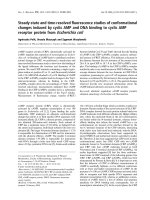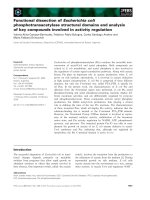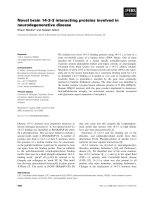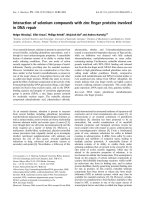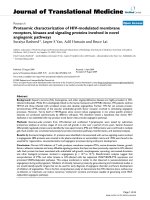Single DNA studies of architectural proteins involved in bacterial pathogenesis and meiosis in saccharomyces cerevisiae
Bạn đang xem bản rút gọn của tài liệu. Xem và tải ngay bản đầy đủ của tài liệu tại đây (4.74 MB, 128 trang )
SINGLE-DNA STUDIES OF ARCHITECTURAL
PROTEINS INVOLVED IN BACTERIAL
PATHOGENESIS AND MEIOSIS IN
SACCHAROMYCES CEREVISIAE
LI YOU
(M.Sc., UT)
A THESIS SUBMITTED
FOR THE DEGREE OF Ph.D. OF PHYSICS
DEPARTMENT OF PHYSICS
NATIONAL UNIVERSITY OF SINGAPORE
2014
i
DECLARATION
I hereby declare that the thesis is my original work and it has been written by
me in its entirety.
I have duly acknowledged all the sources of information which have been used
in the thesis.
This thesis has also not been submitted for any degree in any university
previously.
——————————
Li You
April 2014
ii
ACKNOWLEDGEMENT
Over the last four years, I have benefitted greatly from my interactions with
many people in the National University of Singapore. Their professional assistance
and coaching are invaluable in my research development. My deepest gratitude goes
to my supervisor, A/P YAN Jie. Through my years of study in his group, Yan Jie’s
ongoing patience and inspiration have been indispensable in my scientific growth. As
a principle investigator, his curiosity and fearlessness have been a huge
encouragement in developing my approaches of work and thoughts of experiments.
As an advisor, he serves as a model that I admire and respect fully.
I am also grateful to our collaborators Prof. Linda Kenney, Prof. K.
Muniyappa and Dr. Gauthier. Our collaborations have improved my research in many
ways and will continue to be fruitful for years to come.
Throughout my life, my parents’ love, encouragement, and understanding
have been of utmost importance, and I thank them for everything they did and they
are doing.
My friends in the lab have provided me with lots of support and useful
discussion. I am thankful to have them around. I would like to express my special
thanks to Dr. Qu Yuanyuan for being such a good friend always cheering me up.
Last but not least, I am thankful to my husband, Thomas Masters, for his love,
support, encouragement, critique, and wisdom. As a scientist, he serves as a model of
integrity and discipline that has shaped my life philosophy. He is my most trusted
friend/mentor and I can never finish my Ph.D degree without him.
iii
TABLE OF CONTENTS
DECLARATION i!
ACKNOWLEDGEMENT ii!
TABLE OF CONTENTS iii!
SUMMARY v!
LIST OF FIGURES vi!
LIST OF ABBREVIATIONS ix!
CHAPTER 1: Introduction 1!
1.1 DNA structure and its coil size 1!
1.2 Overview of chromosomal DNA organization in eukaryotic and prokaryotic cells 8!
1.3 Gene expression and gene silencing 10!
1.4 DNA binding modes of nucleoid-associated proteins (NAPs) and their regulatory
functions in bacteria 12!
1.5 Gene-silencing by H-NS and anti-silencing by antagonizing proteins 14!
1.7 Salmonella pathogenesis and the H-NS anti-silencing protein SsrB 21!
1.8 Pathogenic Gram-positive bacterial and current understanding of their nucleiod
structuring proteins — Mtb protein MDP1 and mIHF 24!
1.9 Chromosome synapsis during meiosis 26!
1.10 Objectives of this study 30!
1.11 Organization of this thesis 31!
CHAPTER 2: Methods and materials 33!
2.1 Single molecule manipulation 33!
2.2 Magnetic tweezers and its application to DNA measurements 34!
2.2.1 Magnetic tweezers setup 34!
2.2.2 Coverslip functionalization 37!
2.2.3 Force Calibration 39!
2.2.4 Single-DNA determination 42!
iv
2.2.5 Effects of DNA-binding proteins on FE curves 42!
2.3 Atomic force microscopy 45!
2.3.1 Components of AFM 46!
2.3.2 Principle of AFM 48!
2.3.3 Mica surface modification 52!
CHAPTER 3 Single DNA study of the H-NS antagonizing Salmonella enterica
response regulator SsrB 55!
3.1 Introduction 55!
3.2 Method 56!
3.3 Results 57!
3.4 Discussion 64!
CHAPTER 4 Single DNA study of Mtb protein MDP1 and mIHF 67!
4.1 Introduction 67!
4.2 Method 68!
4.3 Results 72!
4.4 Discussion 85!
CHAPTER 5 Single DNA study of Hop1-DNA interaction 89!
5.1 Introduction 89!
5.2 Method 91!
5.3 Results 91!
5.4 Discussion 95!
CHAPTER 6 Conclusions 97!
BIBLIOGRAPHY 101!
LIST OF PUBLICATIONS 116!
v
SUMMARY
Both eukaryotic and prokaryotic cells must keep their chromosomal DNA well
organized. Packaging of millimeter-long DNA molecules inside bacterial cells and
centimeter-to-meter-long ones inside eukaryotic cells is achieved through a number of
DNA binding architectural proteins. In bacteria, chromosomal DNA is packaged into
a tightly folded nucleoid structure by about a dozen nucleoid-associated proteins
(NAPs). In eukaryotic cells, DNA is organized into chromatin by histone proteins.
Besides packaging DNA, architectural proteins also play other roles in various critical
cellular processes, such as gene transcription regulation and cell division. In the
preparation of this thesis, I investigated the gene regulation functions of H-NS, a
major NAP in Gram-negative bacteria, which controls pathogenesis of Salmonella,
Escherichia coli (E.coli) and Yersinia. My studies revealed the mechanism by which
H-NS mediated gene-silencing can be relieved through interaction with another
protein, SsrB. I also investigated the DNA-binding properties of MDP1 and mIHF,
two acid-fast Gram-positive bacteria proteins expressed in Mycobacterium
tuberculosis. These proteins are known to control bacterial growth and regulate entry
into the dormant state, but the molecular mechanisms were poorly understood. I found
that both of these proteins condense DNA into a stable structure. This suggests they
function to protect DNA against reactive oxygen intermediate by host immune system
and thus play a role in bacterial growth regulation. Finally, I studied the DNA-binding
behavior of the protein Hop1, which plays a critical role in aligning two sister
chromatids during meiosis in the eukaryote Saccharomyces cerevisiae. I found that
Hop1 mediates tight DNA bridging in a zinc ion dependent manner, which has
important physiological implications. All these studies were based on direct
measurement using a combination of single-DNA manipulation and atomic force
imaging technologies to address fundamental questions concerning the mechanical
aspects of interactions between architectural proteins and single-DNA molecules.
vi
LIST OF FIGURES
Figure 1.1 The basic structure of DNA 2!
Figure 1.2 The worm-like chain 4!
Figure 1.3 Force-extension curves for DNA 6!
Figure 1.4 The common and different features of prokaryotic and eukaryotic cells 8!
Figure 1.5 Chromatin and condensed chromosome structure 9!
Figure 1.6 The meiotic cell cycle 10!
Figure 1.7 The central dogma of molecular biology 11!
Figure 1.8 Binding modes of various Gram-negative bacteria NAPs 13!
Figure 1.9 Solution structures of H-NS. 16!
Figure 1.10 Two H-NS DNA-binding modes 17!
Figure 1.11 Possible H-NS gene-silencing mechanisms. 19!
Figure 1.12 Illustration of the mechanisms by which anti-silencing proteins
antagonize H-NS silencing system 20!
Figure 1.13 The TTSS of S. typhimurium 21!
Figure 1.14 The structure of SsrBC 22!
Figure 1.15 Three-dimensional model of SsrBC bound to DNA. 23!
Figure 1.16 Dimerization formation of MDP1 N terminal domain 25!
Figure 1.17 CD analysis of mIHF-80 reveals its high content of alpha-helices 26!
Figure 1.18 Illustration of prophase I stages in meiosis I 27!
Figure 1.19 Structure of the synaptonemal complex. 28!
Figure 2.1 Glass channel for magnetic tweezers experiment. 35!
Figure 2.2 Illustration of a DNA tether 36!
Figure 2.3 Magnetic tweezers setup 37!
Figure 2.4 Steps in the glass coverslip functionalization protocol. 38!
Figure 2.5 The inverted pendulum representation of the bead-DNA configuration 40!
Figure 2.6 Force-extension response of a double-stranded DNA 43!
vii
Figure 2.7 Schematic models for protein introduced changes on double-stranded
DNA 44!
Figure 2.8 Effect of protein nonspecifically binding DNA. 45!
Figure 2.9 AFM setup 47!
Figure 2.10 Cantilever deflection detection by optical lever 48!
Figure 2.11 The AFM probe tip is typically immersed in the contamination layer
above the sample layer 49!
Figure 2.12 Qualitative illustration of interaction force versus surface-to-tip distance.
50!
Figure 2.13 Two AFM imaging modes are divided by their tip working regions 51!
Figure 2.14 Three imaging modes in vibrating mode 52!
Figure 2.15 Schematic illustration of APTES and Glutaraldehyde modified mica
surfaces. 53!
Figure 3.1 H-NS exhibits distinct behaviors to bind to DNA in buffer with and
without magnesium 56!
Figure 3.2 Time course for the SsrB folding events. 58!
Figure 3.3 FE curves for the SsrB folding events 59!
Figure 3.4 SsrB induces strong folding of DNA 60!
Figure 3.5 Salt concentration affects the DNA-folding ability of SsrB 61!
Figure 3.6 SsrB competes with H-NS in stiffening buffer 62!
Figure 3.7 SsrB dose not displace H-NS from DNA in the H-NS DNA-bridging mode.
64!
Figure 3.8 Illustration of the mechanism of SsrB 66!
Figure 4.1 Finding unfolding steps 71!
Figure 4.2. Representative AFM images of MDP1 nucleoprotein in 50 mM KCl 73!
Figure 4.3 Representative AFM images of MDP1 nucleoprotein in 200 mM KCl 75!
Figure 4.4 DNA compaction by different concentrations of MDP1 77!
Figure 4.5 Fitting for the unfolding events using the step-finding algorithm 79!
Figure 4.6 Histogram of the probability density against step sizes 80!
Figure 4.7 Model of two modes of DNA organization by MDP1. 81!
viii
Figure 4.8 AFM images of mIHF nucleoprotein complex in 50 mM KCl 83!
Figure 4.9 DNA compaction by different concentrations of mIHF in 50 mM KCl. 84!
Figure 5.1 S.cerevisiae Hop1 bridges DNA 90!
Figure 5.2 Hop1 protein promotes DNA folding 93!
Figure 5.3 Hop1 C-terminal domain (Hop1ctd) has much less DNA folding effect 94!
ix
LIST OF ABBREVIATIONS
DNA = Deoxyribonucleic Acid
WLC = Worm-Like-Chain
RNAP = RNA Polymerase
mRNA = messenger RNA
tRNA = transfer RNA
NAPs = Nucleoid-Associated Proteins
E. coli = Escherichia coli
Fis = Factor for Inversion Stimulation
HU = Heat Unstable nucleoid protein
H-NS = Histone-like Nucleoid Structural protein
IHF = Integration Host Factor
Dps = DNA-binding Protein from Starved cells
StpA = Suppressor of Td mutant Phenotype A
Mtb = Mycobacterium tuberculosis
MDP1 = Mycobacterial DNA-binding Protein 1
mIHF = mycobacterial Integration Host Factor
S. Typhimurium = Salmonella Typhimurium
TTSS = Type III Secretion System
SPI-1 = Salmonella Pathogenicity Island 1
SPI-2 = Salmonella Pathogenicity Island 2
SC = Synaptonemal Complex
CE = Central Element
LE = Lateral Elements
AFM = Atomic Force Microscopy
PBS = Phosphate Buffered Saline
x
FE curve = Force-Extension curve
STM = Scanning Tunneling Microscope
APTES = (3-Aminopropyl)triethoxysilane
EDTA = ethylenediaminetetraacetate
Hop1 wt = Hop1 wild type
Hop1 ctd = Hop1 C-termianl domain
1
CHAPTER 1: Introduction
1.1 DNA structure and its coil size
This thesis is focused on architectural proteins in eukaryotes and prokaryotes.
The term “architectural proteins” derives from the important roles they play in
constructing and organizing cellular chromosomal DNA (Deoxyribonucleic acid). The
functional mechanisms of these proteins depend on their interaction with DNA.
Therefore I will first introduce the structural properties of the genetic material, DNA,
which is organized by these proteins.
DNA is a biopolymer consisting of repeating subunits termed nucleotides.
Each nucleotide is composed of a nucleobase, its attached sugars (deoxyribose) and
the phosphoric acid groups. There are 4 nucleobases: guanine, adenine, thymine, and
cytosine (usually abbreviated as G, A, T and C). The deoxyribose sugars form the
DNA backbone through phosphodiester bonds to neighboring phosphate groups (1).
Most DNA molecules are double-stranded helices and each helix coils around
the same axis with a radius of 1 nm. The nucleobases are paired with each other
across the helix, but only A-T and C-G. Two adjacent base pairs has a distance of
~0.34 nm and rotate relative to each other by approximately 36°. One helical pitch has
around 10.5 base pairs (3.6 nm). The twin helical strands intertwine and form two
kinds of grooves, the major groove, is 22 Å wide and the other, the minor groove, is
12 Å wide (Figure 1.1).
2
Figure 1.1 The basic structure of DNA. DNA is a molecule composed of two strands inter-
winding with each other. The two strands are the backbones, which are made from sugar-
phosphates. The two strands rotate about the same axis and form two grooves with the large
groove of 22 Å and small groove of 12 Å. Nucleobases are connected with the sugar
backbones and they form pairs only as A-T and G-C. The distance between the backbones is
20 Å. The three components that include the phosphate, the sugar and the base are called the
DNA nucleotide. (Illustration from (1)).
DNA encodes the genetic information for the development and functioning of
all living organisms and many viruses. Two features of DNA make it ideal for
biological information storage. Firstly, the DNA backbone is able to protect DNA
from cleavage, and secondly, the double-stranded structure favors the duplication of
the genetic information contained in the sequence of the four nucleobases.
Within cells, DNA is organized into highly compact structures called
chromosomes. The contour length of the chromosomal DNA is centimeters to meters
in eukaryotic cells and millimeters in prokaryotic cells. Due to the finite bending
rigidity of the DNA backbone, a long DNA molecule adopts a random-coiled
conformation driven by thermal energy. In a coiled conformation, the distance
between the two DNA ends (hereafter is referred to as end-to-end distance),
!
!
R
, is
much shorter than the contour length.
3
The necessity of packaging the genomic DNA within a cell becomes clear
when one compares the volume of random coiled DNA to the volume of a typical
cell. To determine this volume ratio, a series of prerequisites need to be assumed as
follows; the random coiled shape is not a specific conformation but a statistical
distribution that is determined by the DNA bending rigidity. DNA conformations are
controlled by the interplay between thermal energy and the bending stiffness of DNA
backbone. In DNA polymer models, the bending energy of DNA with a contour
length L is given by:
!
E
k
B
T
=
A
2
ds
d
ˆ
t
d
ˆ
s
"
#
$
%
&
'
0
L
(
2
,
!
(1)
where s is the arc length along the DNA contour from one end,
!
d
ˆ
t
d
ˆ
s
is the
curvature of the DNA polymer, and A is a parameter describing the bending rigidity
of DNA. A has the dimension of length and is called the DNA bending persistence
length. DNA shorter than the persistence length can be envisaged as a rather straight
rod, whereas DNA much longer than the persistence length is a random coil (Figure
1.2 (A)). k
B
is the Boltzmann constant and T is the temperature. This model is often
known as the worm-like-chain (WLC) polymer model of DNA. It is crucial to know
the exact value of A to understand DNA bending induced conformations by thermal
energy.
4
Figure 1.2 The worm-like chain. Schematic diagram of (A) random DNA coil.
!
!
R
is the end-
to-end distance. (B) Schematic diagram of DNA polymer under force f in the direction of x. t
is the tangent veter.
Accurate values of A have recently been measured through mechanically
stretching a single DNA molecule using single-molecule manipulation techniques
such as optical tweezers and magnetic tweezers (2). Such techniques allow us to apply
tensile forces by pulling the two ends of individual DNA molecules (Figure 1.2 (B)).
The force tends to extend the DNA conformation, in opposition to thermal energy that
tends to coil the DNA. The competition between these two factors determines the
equilibrium distance between two DNA ends. In a single-DNA stretching experiment,
the DNA extension x, which is the end-to-end distance
!
!
R
projected along the force
direction, is measured in real time with nanometer spatial resolution.
In the presence of applied force, the conformational free energy of DNA
becomes:
!
E
k
B
T
=
A
2
dt
ˆ
( s)
ds
"
#
$
%
&
'
2
(
!
f
k
B
T
t
ˆ
( s)
)
*
+
+
,
-
.
.
0
L
/
ds,
!
(2)
with the first term describing the contribution from DNA bending and the second term
describing the contribution from force. The second term has a negative sign in front of
the force because DNA elongation by the force reduces the DNA free energy.
5
With this conformational energy of DNA under force, its partition function
becomes:
!
Z = e
"
E
i
k
B
T
i
#
,
!
(3)
where i indicates one of the DNA conformations, and E
i
is the corresponding
conformational energy. The summation includes all possible DNA conformations.
The partition function can be calculated numerically by Monte-Carlo simulation or
transfer-matrix method (3-5). It can also be analytically obtained under certain
asymptotic conditions (large force limit or small force limit). The extension as a
function of force (i.e., the force-extension curve) can be obtained from the partition
function:
!
x =
"
ln Z
"
f
k
B
T
#
$
%
&
'
(
,
!
(4)
At small force limit f << k
B
/A, the analytical force-extension curve is known
as:
!
f <<
k
B
T
A
"
x( f )
L
=
2Af
3k
B
T
,
!
(5)
In 1995, Marko derived an analytical formula for the force-extension curve for
the WLC model at large force limit f >> k
B
/A (6):
!
f >>
k
B
T
A
"
x( f )
L
= 1 #
k
B
T
4 Af
,
!
(6)
Direct interpolation of the force-extension curves obtained at the two force
limits leads to a formula (known as the Marko-Siggia formula) that accurately
describes the force-extension curves of WLC polymers over a wide force range.
!
fA
k
B
T
=
x
L
+
1
4(1 " x L)
2
"
1
4
,
!
(7)
Fitting the experimental data with the Marko-Siggia formula, the value of A
was determined to be around 50 nm in physiological solution conditions (6, 7) (Figure
1.3).
6
Figure 1.3 Force-extension curves for DNA. Squares are force extension curve of 97 kb
double-stranded !-DNA. The solid line is the fit by the Marko-Siggia formula. The fit
parameters are the DNA contour length L= 32.8±0.1 µm and the persistence length
A=53.4±2.3 nm. The dashed line is the freely joined chain model for fitting comparison
(Figure adopted from Bustamante et. al (7)).
The energy of the WLC model can be discretized into a chain of N small
straight segments with a segment length b << A with the following substitutions:
!
ds " b
ds " b
i=1
N #1
$
0
L
%
dt
ˆ
( s)
ds
"
ˆ
t
i+1
#
ˆ
t
i
b
dt
ˆ
( s) "
ˆ
t
i
,
!
(8)
Therefore the discrete WLC model has a form of:
7
!
E
k
B
T
=
A
2b
(
ˆ
t
i+1
"
ˆ
t
i
)
2
"
!
f b
k
B
T
ˆ
t
i
#
$
%
&
'
(
i
N "1
)
,
!
(9)
In the absence of force, DNA coils when its contour length is much longer
than A ~50 nm, and its conformation can be understood through a three dimensional
random walk process with a step size b = 2A ~100 nm (6). The average of the square
of the end-to-end distance
!
!
R
is related to the number of steps and the step size
through:
!
R
2
= N " b
2
= L " b,
where N is the number of the segments, L=Nb is the contour length. Therefore, the
dimension of the random coils of a long DNA can be estimated by:
!
l
coil
= L " b,
!
(11)
The volumes of the random coils can be estimated by l
coil
3
= (Lb)
3/2
.
Typical lengths of genomic DNA in eukaryotic and prokaryotic cells are in the
magnitude of meters and millimeters, respectively. They correspond to random coiled
sizes of 3"10
5
nm and 10
4
nm, respectively. Therefore the volume ratio between the
coil size of the chromosomal DNA and the size of a eukaryotic cell is:
!
(3"10
5
nm)
3
(10 "10
3
nm)
3
= (30)
3
,
!
(12)
while for prokaryotic cells, the ratio is:
!
(10
4
nm)
3
(10
3
nm)
3
= (10 )
3
,
!
(13)
Thus unpacked DNA occupies a volume 1000-10000 times that of the cell that
must contain it. This leads to a fundamental question: how do cells pack their
chromosomal DNA into their compartments?
8
1.2 Overview of chromosomal DNA organization in eukaryotic and
prokaryotic cells
In eukaryotic and prokaryotic cells, the chromosome is an indispensable part
of the cell that contains the genetic information necessary for growth and
development. A chromosome is a highly compact nucleoprotein complex organized
by DNA-binding architectural proteins. Typically, a eukaryotic cell (cells with nuclei
such as those found in plants, yeast, and animals) possesses multiple large linear
chromosomes within the cell’s nucleus (Figure 1.4).
Figure 1.4 The common and different features of prokaryotic and eukaryotic cells. (Figure
adapted from (8))
Eukaryotic cells employ an ingenious packaging system that is to wrap DNA
around structural proteins called “histones”, resulting in formation of nucleosomes.
With the assistance from other nucleosome binding proteins, the nucleosome array is
further organized into highly compact chromatin (9). During mitosis and meiosis,
9
chromosomes, which are composed of chromatin, become increasingly condensed
such that they are visible with optical microscopes (Figure 1.5).
Figure 1.5 Chromatin and condensed chromosome structure. In eukaryotes, chromosomal
DNA molecules are packed into nucleosomes by histone proteins and then further organized
into chromatin by scaffold proteins. During cell division, chromatin is condensed further and
results in the classic four-arm structure that is visible under the microscope. (Figure adopted
from (10))
Meiosis is a key process in sexual reproduction. In this process, DNA
molecules originating from two different individuals (parents) join up (chromosome
pairing) so that homologous sequences are aligned with each other, and this is
followed by exchange of genetic information (a process called genetic recombination)
to ensure genetic diversity of the offspring. Unlike mitosis, chromosomes in meiosis
shuffle the genes and undergo a recombination that results in a different genetic
combination in each gamete (Figure 1.6). Several architectural proteins mediate
chromosome pairing during meiosis, however, how they perform their function
through DNA binding remains unclear. To address this, in one of my Ph.D research
projects, DNA binding properties of a protein called Hop1 were studied to explore its
key role in mediating chromosome pairing in Saccharomyces cerevisiae (yeast) that
will be discussed in Chapter 5.
DNA packaging in prokaryotic cells is different from that in eukaryotic cells
because prokaryotes do not have defined nuclei as eukaryotes. Furthermore,
prokaryotes often have a shorter chromosomes, usually arranged in a circular form
10
with DNA tightly coiled on itself, accompanied by one or more smaller circular DNA
molecules called plasmids. Instead of packaging chromosomal DNA into chromatin
like eukaryotic cells, their DNA is organized into a structure called nucleoid by a
number of non-histone DNA binding proteins that will be discussed in later sections.
Figure 1.6 The meiotic cell cycle. Prior to meiosis, chromosomes condense and homologues
pair up or synapse followed by crossover (chiasma formation). Then, homologue
chromosomes align themselves and each chromosome is drawn to the opposite end of the cell,
referred to as meiosis I. A second division occurs resulting in four haploid cells and this
process is referred to as Meiosis II. (Figure reproduced from(11))
1.3 Gene expression and gene silencing
Chromosomal DNA encodes the vast majority (and sometimes the entirety) of
an organism's genetic information. Genes are sections of DNA that contain the
instructions for making proteins. Each gene encodes a specific protein, which is
transcribed by RNA polymerase (RNAP) and finally translated into protein by
ribosome (the central dogma, Figure 1.7). Once the polypeptide chain is produced,
the three-dimensional structure of the protein will form subsequently through a
process called protein folding. The whole process of conversion of the information
encoded in a gene first into messenger RNA (mRNA) and then into protein is termed
as “gene expression”. Genes are expressed only when they are needed for cellular
functions. Therefore, the abundance of genes is tightly controlled through regulation
11
of gene expression. The expression level of many genes are suppressed through gene
silencing, which is of great importance as proteins are critically involved in the proper
function and structure of cells.
Figure 1.7 The central dogma of molecular biology. There are two steps for producing a
corresponding protein: transcription and translation. Transcription occurs in the nucleus of the
cell resulting in the formation of a copy of the information encoded in a gene in the form of
messenger RNA (mRNA) with the help of RNA polymerase. The mRNA subsequently
travels out of the nucleus, and the genetic information it carries is used to produce a specific
protein with the help of ribosome and transfer RNA (tRNA), a process known as translation.
Once the protein is produced, it will adopt a three-dimensional structure through folding. The
whole process of conversion of the information encoded in a gene first into mRNA and then
to a protein is termed as “ gene expression”. (Figure from (12)).
12
1.4 DNA binding modes of nucleoid-associated proteins (NAPs) and
their regulatory functions in bacteria
The bacterial nucleoid contains approximately a dozen nucleoid-associated
proteins (NAPs). In addition to organizing the bacterial nucleoid, those NAPs also
have impact on gene expression either positively (transcription enhancers) or
negatively (gene silencers).
In Escherichia coli (E.coli), the nucleoid exhibits a “protein-crosslinked
elastic filamentous” conformation in all growth conditions (13). It is made up of
randomly moving, supercoiled domains at short scales (< 0.1 µm), but a self-adherent
nucleoprotein complex at longer length scales, which would most likely be mediated
by NAPs. It has long been known that the relative abundances of major NAPs vary in
different growth phases (14-18). In the exponential growth phase, the most abundant
NAPs in E. coli cells are Fis (factor for inversion stimulation), HU (heat unstable
nucleoid protein), and H-NS (histone-like nucleoid structural protein); while in the
transition from the exponential phase to the stationary phase, IHF (integration host
factor) becomes the second-most abundant NAP and in the stationary phase, whilst
Dps (DNA-binding protein from starved cells) is the most abundant NAP. The
localizations of some of the NAPs on the nucleiod in E. coli were recently visualized
using super-resolution fluorescence techniques in vivo at the early exponential phase
(19). H-NS forms a few compact clusters within each cell. In contrast, HU, Fis, and
IHF form largely scattered distributions throughout the nucleoid. These proteins work
collectively to regulate the cell in the different growth phases.
The NAPs bind to DNA through different modes, which are directly related to
their functions. Different NAPs employ different mechanisms of DNA recognition
and organize DNA into different conformations (Figure 1.8). IHF and HU bind to
DNA non-cooperatively causing DNA bending (20) at low protein binding density.
While at high protein binding density, IHF can crosslink DNA causing DNA
condensation in the presence of a physiological concentration of magnesium (21) and
HU can cause DNA stiffening (20). Fis bends and mediates DNA looping (22, 23). H-
13
NS family proteins (H-NS and StpA in E. coli) bind to DNA cooperatively, leading to
formation of rigid nucleoprotein filaments. H-NS may also mediate DNA bridging
and higher order structures depending on buffer conditions, in particular the
magnesium concentration (24-27). Dps-DNA complexes showed highly ordered and
tightly packed Dps-DNA co-crystals (28). Within nucleoids condensed by Dps, the
genomic DNA is effectively protected by means of structural sequestration, and the
sequestration of macromolecules in crystalline assemblies provides an efficient means
for protection (29). Due to the different DNA binding properties of the NAPs (Figure
1.8), the change in their relative abundance results in different levels of nucleoid
packaging.
Figure 1.8 Binding modes of various Gram-negative bacteria NAPs. (a) IHF proteins bend
DNA. (b) HU proteins stiffen circular DNA at high protein concentration. (c) Fis causes DNA
looping. (d) H-NS proteins fold DNA in high magnesium concentration. (e) Dps self-
aggregates when associated with DNA (Figures revised from (30) ).
E. coli is a species of Gram-negative bacteria whose cell wall is composed of a
single layer of peptidoglycan surrounded by a membranous structure called the outer
membrane. In contrast, a Gram-positive bacterium has a cell wall consisting of



